Geography Class 12 Important Questions Chapter 2 The World Population (Distribution, Density and Growth)
1 Mark Question
Question 1.
How is the density of population of a region calculated? Delhi 2015
Answer:
The density of population refers to a ratio between the total population and the total land area in a country. It can be calculated as![]()
Question 2.
Define the term ‘population distribution’. Delhi 2015
Answer:
Population distribution means an arrangement of people over the earth’s surface. The population distribution in the world is uneven.
Question 3.
Name the most densely populated region of North America, AH India 2013
Answer:
The most densely populated region of North America is North-Eastern part of U.S.A.
Question 4.
Give the meaning of ‘Crude Birth Rate (CBR)’. (Delhi 2013)
Answer:
The Crude Birth Rate (CBR) is expressed as the number of live births in a year per thousand of a population. It is calculated as:
Where, Bi = Live births during the year and P = Mid-year population of the area.
Question 5.
Which continent has the highest growth rate of a population? (Delhi 2012,2009)
Answer:
The highest growth rate of population is in Africa.
Question 6.
Define the term density of population. (Delhi 2012)
Answer:
A ratio between population and land area in a country is called population density. It is calculated by dividing the number of people by area which is usually shown as the number of people per square kilometres.
Question 7.
Define the population growth. All India 2012
Answer:
Population growth refers to the change in the number of inhabitants of territory during a specific period of time.
Question 8.
Define the term ‘positive growth of population’. All India 2011
Answer:
When the birth rate is more than the death rate between the two points of time or when people from other countries migrate permanently to a region is called positive growth of population.
3 Marks Questions
Question 9.
Explain any three push and any two pull factors that influence the migrations of a population in the world. (All India 2016)
OR
How is the mortality rate of a region affected? Explain any four push factors responsible for migration. Delhi 2015
Answer:
Migration is the displacement of people from one place to another. It can be permanent, temporary or seasonal.
The push factors of migration are:
- Unemployment
- Poor living conditions
- Political turmoil
- Unpleasant climate
The pull factors are:
- Better job opportunities.
- Better living conditions.
The mortality rate of a region is affected by the availability of medical and health facilities, sanitation and provision of nutritious food.
Question 10.
Describe any three characteristics of the first stage of ‘Demographic Transition Theory’. Delhi 2014
Answer:
Characteristics of the first stage of Demographic Transition Theory are as follows:
- The first stage has high fertility and high mortality because people reproduce more to compensate for the deaths due to epidemics and variable food supply.
- Most of the people are engaged in agriculture where large families are an asset.
- The population growth is slow.
Question 11.
Describe any three characteristics of the last stage of ‘Demographic Transition Theory’. All Indio 2014
Answer:
Characteristics of the last stage of Demographic Transition Theory are as follows:
- In this stage both fertility and mortality decline.
- The population is either stable or grows slowly.
- The population becomes urbanised, literate and has the high technical know-how.
Question 12.
Explain with example any three geographical factors which influence the distribution of the population in the world. Delhi 2008
Answer:
The three geographical factors which influence the distribution of the population in the world are as follows:
Availability of Water It is an essential component for life. The region with fresh water is the most preferred place to live in. That’s why places near river valleys are densely populated.
Landforms The region with fertile plain is most populated as compared to mountainous and hilly areas because these hinder the agricultural and industrial development.
Climate It plays a very important role in population concentration. This is because area having a moderate climate with moderate rainfall have more population whereas area with heavy rainfall and harsh climate have low population.
5 Marks Questions
Question 13.
“90 per cent of the world population lives in about 10 per cent of its total land area, whereas the remaining 10 per cent population resides in the 90 per cent of its land area”. Support the statement with suitable examples. (Delhi 2017)
Answer:
It is true that 90 per cent of the world population lives in about 10 per cent of its total land area, whereas remaining 10 per cent population resides in the 90 per cent of its land area. The factor which affects the distribution of the population in the world are:
Cultural Factors Traditions and culture of a place includes the distribution of a population. People like to migrate in areas where common tradition and culture are found.
Physical Factors Relief, climate, soil and mineral are the physical factors which determine the population of any place. Tibet is the region of very less population, whereas Indo-Gangetic plain is overpopulated.
Means of Transport Regions with better facilities of means of transport lead to a better economic condition. This lead to a thick population. Mumbai-Pune Industrial region is the best example.
Economic Condition Industrial and agricultural regions of the world are thickly populated. Industrial region of India, USA, Japan, UK are the examples.
Question 14.
What is the meaning of density of population? Examine the four geographical factors that influence the distribution of the population in the world with suitable examples. (Delhi 2017)
Answer:
Population density refers to a ratio between the total population and the total land area in a country. A density of population is an important measure to analyse population distribution. Geographical factors that influence the distribution of the population in the world are:
Relief Features Relief is the most important physical factor influencing the distribution of a population. High mountains, rugged terrain and some of the plateaus restrict human settlements.
Plains River valley has fertile soil. The plain area provides a better living condition. The nature of surface permits a wider scope for agriculture industries, transport and urbanisation.
Climate It has a direct influence on human beings. Man refers to live in normal conditions of temperature and rainfall. Excessive heat, cold, dryness or wetness restrict the human population. Apart from human health, climate affects agriculture also. Asia, North-West Europe and North America are areas of dense population.
Soil It is an important factor for the survival of humanity. Fertile soil supports agriculture. High degree of population concentration in South-East Asia is primarily due to fertile soil. Most of the world’s fertile soil is found in the river valley of Ganga, Indus, Huang Ho, Mississipi, etc.
Question 15.
What is ‘demographic cycle’? Describe three stages of Demographic Transition Theory? Delhi 2016
Answer:
The demographic cycle represents the changes in the population of a region as it moves from high births and high deaths to low births and low deaths as that region/society progress from rural, agrarian and illiterate to an urban, industrial and literate society.
These changes occur in three stages that are collectively called Demographic Transition Theory.
The three stages are as follows:
The First Stage This stage is marked by high fertility and high mortality. The death rate is also high due to epidemics and variable food supply. Therefore, the population growth is slow and life expectancy is low. People are mostly illiterate and engaged in agriculture due to which large families are preferred. Level of technology is also low.
Second Stage In this stage, the expansion of population remains high because the death rate reduces due to the improvement in sanitation and health conditions but the fertility rate remains high. Though at the later stage it declines with time. The mortality rate also decreases. The net addition to a population in this stage is high.
The third Stage In the last stage, both fertility and mortality declines considerably and population either stabilises or grows slowly. The family size is deliberately controlled as the population becomes urbanised and literate. There is a high level of technical know-how in this stage. High technical knowledge contributes deliberately in controlling the family size.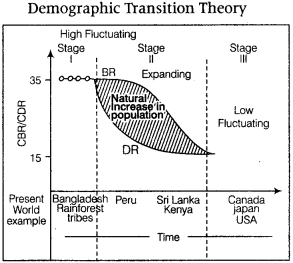
Question 16.
When does positive population growth takes place? Explain the geographical factors that influence the distribution of the population in the world. (HOTS: Delhi 2015)
Answer:
When the birth rate is more than the death rate between the two points of time or when people from other countries migrate permanently to a region is called positive growth of population.
For geographical factors,
The three geographical factors which influence the distribution of the population in the world are as follows:
Availability of Water It is an essential component for life. The region with fresh water is the most preferred place to live in. That’s why places near river valleys are densely populated.
Landforms The region with fertile plain is most populated as compared to mountainous and hilly areas because these hinder the agricultural and industrial development.
Climate It plays a very important role in population concentration. This is because area having a moderate climate with moderate rainfall have more population whereas an area with heavy rainfall and harsh climate have low population.
Question 17.
Explain the trends in population growth of the world with special reference to the help of science and technology. (HOTS; All India 2015)
Answer:
The trends in population growth show that from the sixteenth and seventeenth century there had been a considerable rise in population. World population exploded in the eighteenth century after the advancement of science and technology brought changes like the industrial revolution, better means of transportation and improvement in agriculture. Advancement in science and technology reduced the death rate as the spread of epidemics could be controlled and diseases could be cured.
Therefore, within a span of every 12 years, one billion population is added to the existing number. Improvement in science and technology also helped in lowering the birth rate as many birth control measures are developed but the reduction in birth rate is less than death rate and therefore, there is a sharp rise in the world population.
Question 18.
Explain three economic and two social and cultural factors influencing the distribution of the population in the world. All India 2015
OR
Explain with examples of the three economic factors influencing the population distribution in the world. (All Indio 2011, Delhi 2008)
Answer:
The three economic factors influencing the distribution of population are as follows:
Minerals Areas with mineral deposits attract not only industries but also skilled and semi-skilled workers as they generate huge employment.
Urbanisation Urban centres offer better employment opportunities, education and medical facilities, better means of communication which attract people.
Industrialisation Industrial belts provide job opportunities which attract not only factory workers, but also transport operators, shopkeepers, bank employees, doctors, teachers and other service providers.
Two social and cultural factors influencing the distribution of population are as follows:
Religious and cultural significance Places having religious importance and cultural significance tend to attract the number of people due to which they are densely populated.
Social and political unrest Places where there is political turmoil and social unrest are not fit for living and people to tend to move away from those areas. This makes it sparsely populated.
Question 19.
Explain the three components of population change in the world. Analyse the impacts of population change. Delhi 2014
Answer:
The three components of population change in the world are:
1. Crude Birth Rate It is referred to as a number of live births in a year per thousand of the population. It increases the population.
2. Crude Death Rate It is referred to as a number of deaths in a particular year per thousand of the population in a particular region. It decreases the population.
3. Migration It is a displacement of people from a place of origin to the place of destination. In-migration increases the population. Out-migration decreases the population.
Impacts of population change are as follows:
1. If the population change results in high population growth then it puts pressure on the resources leading to scarcity and other problems.
2. Population change resulting in the decline of the population shows that the available resources are not sufficient to maintain the population.
Question 20.
Describe in brief the different trends of population growth in the world from an early period to the present day. (HOTS; Delhi 2009)
Answer:
The trends in population growth are as follows:
- In the early periods of history i.e. 8000 to 12000 years ago the populations grow at a slow rate.
The population of the era was 8 million. - The count of the population in the first century was below 300 million.
- By 1600 AD world population increased to 0.5 billion as expansion in trade and industrial revolution increased settlements.
- World population touched 1 billion in 1830 due to advancement in the field of science and technology.
- In the next 100 years i.e. 1930, the population doubled to 2 billion due to improved medical, health and sanitation facilities.
- In 1960, the population was 3 billion, in 1975, it was 4 billion after that one billion is added in every 12 years.
- There is a great variation among regions in doubling their population.
Map-Based Questions
Question 21.
On the political outline map of the world identify:
A. The country with the lowest density of population in Asia. (Delhi 2016)
B. Name the country with the smallest population of Asia. (Delhi 2016)
C. The country with the highest growth rate of population in Asia. (All India 2014)
D. The country with the lowest growth rate of population (1995-2000) in Asia. (Delhi 2014)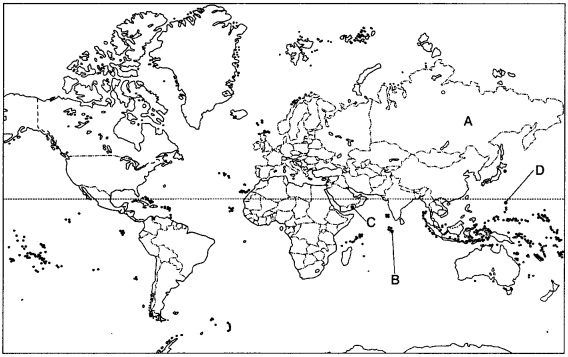
Answer: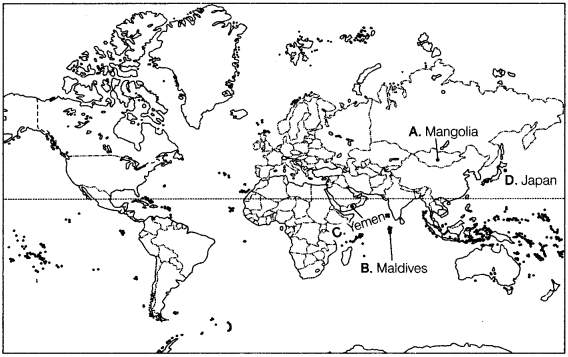
Question 22.
On the political map of the world identify:
A. A country having the highest density of population in Asia. Delhi 2013
B. A country having the largest population in Europe, ail India 2010
C. A country having the lowest density of population in Africa. All India 2009
D. A country having the lowest population growth in Africa. Delhi 2009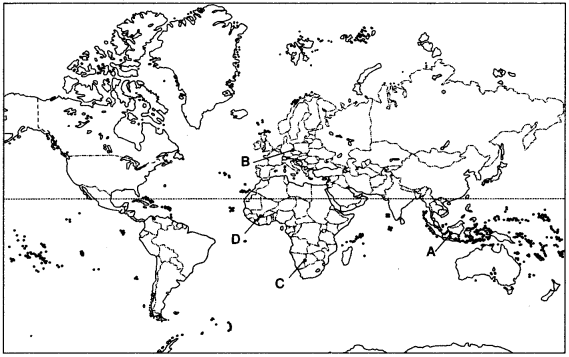
Answer: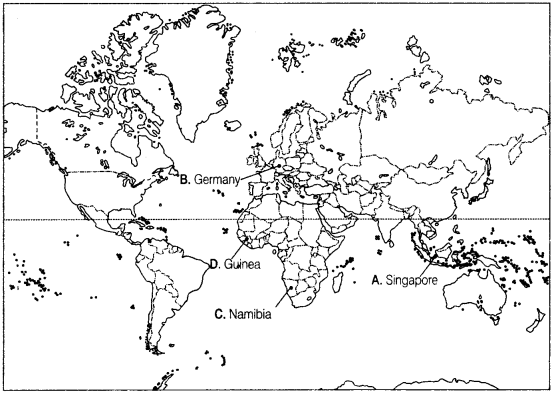
Value Based Questions
Question 23.
When people move from one place to another, the place they move from is called the Place of Origin and the place they move to is called the Place of Destination. The place of origin shows a decrease in population while the population increases in the place of destination. Migration may be interpreted as a spontaneous effort to achieve a better balance between population and resources.
(i) What is the cause of population change?
(ii) Lack of which value lead to migration.
Answer:
(i) Migration is the cause of population change.
(ii) Lack of following values lead to migration:
- Self-respect and unity
- Dedication
- Dignity
Question 24.
Family planning is the spacing or preventing the birth of children. Access to family planning services is a significant factor in limiting population growth and improving women’s health. Propaganda, free availability of contraceptives and tax disincentives for large families are some of the measures which can help population control.
(i) What is a significant factor in limiting population growth?
(ii) Which value leads to family planning?
Answer:
(i) Access to family planning services is a significant factor in limiting population growth.
(ii) Self respect, dignity and preservation of women pride are values which leads to family planning.











